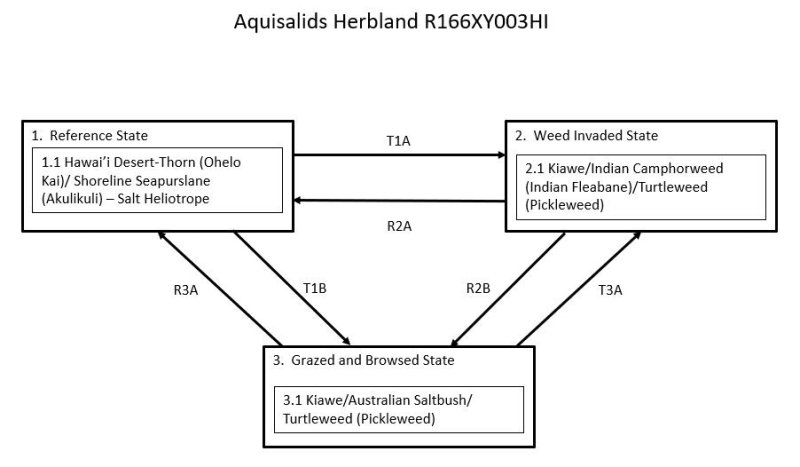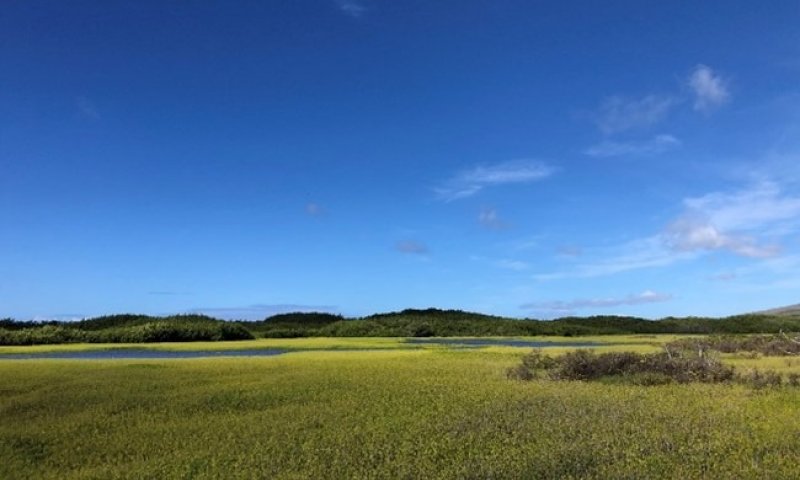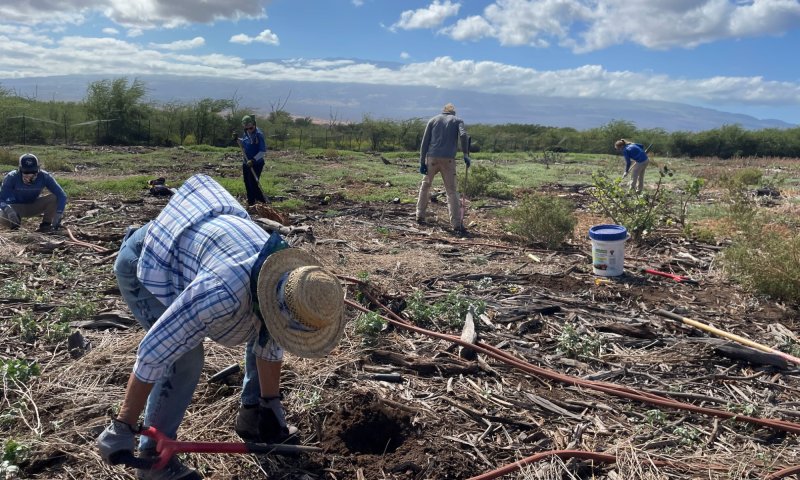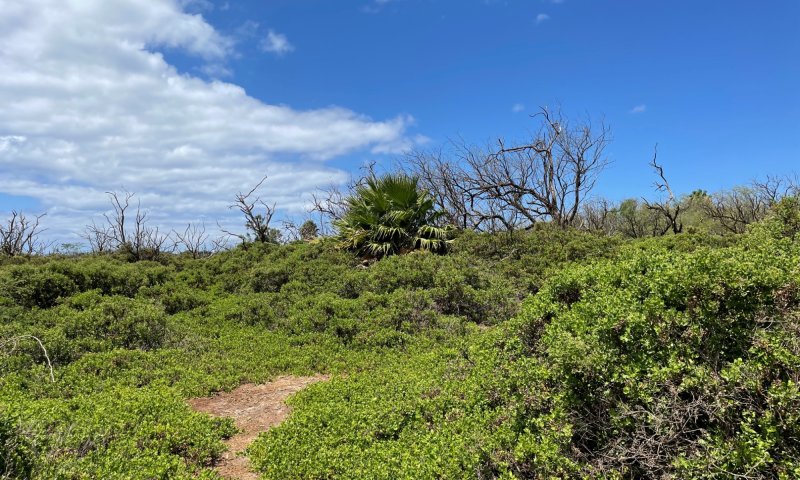

Natural Resources
Conservation Service
Ecological site VX166X01X003
Aquisalids Herbland
Last updated: 5/08/2025
Accessed: 05/20/2025
General information
Provisional. A provisional ecological site description has undergone quality control and quality assurance review. It contains a working state and transition model and enough information to identify the ecological site.
MLRA notes
Major Land Resource Area (MLRA): 166X–Very Stony Land and Rock Land
This MLRA occurs in the State of Hawaii on the islands of Maui, Kahoolawe, Lanai, Molokai, Oahu, Kauai, and Niihau. Elevation ranges from sea level to 8,000 feet (0 to 2,440 meters). The terrain encompasses stony complex slopes and rocky gulches (USDA-NRCS, 2006). The geology is extrusive basic igneous rock (primarily basalt) that are weathered in some areas. Some interfluves are mantled with weathered volcanic ash. Average annual precipitation ranges from 17 to 39 inches (430 to 990 millimeters) (Giambelluca et al., 2013). Extreme average annual precipitation ranges from 10 to 107 inches (254 to 2,720 millimeters). Most of the rainfall occurs from November through March, much of it during kona storms. Average annual air temperatures ranges from 70 to 75 degrees F (21 to 24 degrees C) with little seasonal variation (Giambelluca et al., 2014). Extreme annual air temperatures range from 48 to 82 degrees F (9 to 28 degrees C). Dominant soils are Mollisols, Aridisols, and Entisols with an isohyperthermic, isothermic, or isomesic soil temperature regimes and ustic or aridic soil moisture regimes (USDA-NRCS, 2006). Vegetation consists of forbs, grasses, and shrubs with some trees. Most of the plant species typically encountered are introduced species that have become naturalized in Hawaii. However, areas within this MLRA are critical habitat for rare, threatened, or endangered plant species.
Classification relationships
This ecological site occurs within Major Land Resource Area (MLRA) 166 - Very Stony Land and Rock Land.
The Aha Moku System, which dates back to the 9th century and has been passed down through oral tradition and generational wisdom, effectively sustains Hawaii's natural ecosystems and environment (DLNR, 2024). This site-specific and resource-based approach balances land and ocean resources essential for fostering healthy, thriving communities. Grounded in Native Hawaiian generational knowledge, the Aha Moku System emphasizes community consultation to prioritize the health and welfare of Hawaii’s natural and cultural resources. It is rooted in the concept of 'ahupua'a, the traditional system of land and ocean management in Hawaii. For collaboration, this ecological framework encompasses the following mokus:
Molokai Moku Acres: Kona (1,571).
Maui Moku Acres: Pu'ali Komohana (660), Lahaina (233), and Kula (43).
Ecological site concept
This ecological site supports a mix of forbs, grasses, shrubs, and a few trees (USDI-USGS, 2006). It occurs on nearly level coastal flats in scattered locations on the southwestern coast of Maui and southern coast of Molokai. Examples can be seen at Maalaea Haycraft Beach Park and Kealia Ponds Preserve on Route 31 on Maui, locations along Route 30 on West Maui, and along Route 450 on Molokai.
The central concept of the Aquisalids Herbland Ecological Site is of poorly drained, very deep soils formed in alluvium over beach sand. Soils are frequently ponded; a fluctuating, brackish water table is present at depths ranging from approximately 12 to 40 inches (305 to 1016 millimeters) (USDA-SCS, 1972). The ecological site occurs between elevations of 0 to 10 feet (0 to 3 meters) with extremes up to 100 feet (30 meters). Annual air temperatures and proximity to the ocean are associated with warm (isohyperthermic), water-saturated and anaerobic (aquic), saline soil conditions. Annual rainfall (20th and 80th percentiles) averages 23 to 27 inches (584 to 686 millimeters) (Giambelluca et al., 2013). Vegetation consists of forbs, grasses, shrubs, and trees that are adapted to survival in these unique conditions (USDA-SCS, 1972).
It appears that some examples of this community that are located on alluvial outwash from gulches emerging from the mountains may receive freshwater runoff that produces less-saline conditions, allowing some species not typically associated with high salinity tolerance to flourish.
Associated sites
| VX163X01X002 |
Sandy Shrubland The Sandy Shrubland Ecological Site (R163XY002HI) co-occurs with this ecological site on Maui. It differs from this ecological site in its deep, sandy, excessively drained, and typically dry soils rather than poorly drained silt loam soils. However, one phase of this deep, dry, sandy soil has a shallower water table than most of this soil series; in microsite troughs in the terrain where this saline groundwater is at or near the surface, the two ecological sites may share some plant species. |
|---|---|
| VX166X01X001 |
Isohyperthermic Torric Naturalized Grassland The Isohyperthermic Torric Naturalized Grassland Ecological Site (R166XY001HI) co-occurs with this ecological site on Molokai, where it forms the immediate upland area adjoining this ecological site. It is well drained rather than poorly drained and support dry upland vegetation rather than the primarily saline wetland species of this ecological site. |
| VX158X01X002 |
Isohyperthermic Torric Naturalized Grassland Kiawe/buffelgrass (Prosopis pallida/Pennisetum ciliare) The Isohyperthermic Torric Naturalized Grassland Ecological Site (R158XY002HI) has a similar climate to this ecological site, but its soils are different. It has well drained soils rather than poorly drained soils which are shallow to a brackish water table. The two ecological sites share some plant species. |
Similar sites
| VX163X01X005 |
Aquic Coastal Wetland The Aquic Coastal Wetland Ecological Site (R163XY005HI) and this ecological site are similar in the following ways: They are both wetlands with poorly, to very poorly drained soils which are subject to flooding and ponding, and they both occur along coastlines on coastal plains where they share similar elevations and climates. While they share some wetland species these ecological sites have predominantly different dominant species, different species compositions, and different vegetative structure. This ecological site is an herb land while R163XY005HI is predominantly dominated by Hau trees. This ecological site occurs on Maui and Molokai while R163XY005HI occurs on Oahu and Kauai. |
|---|
Table 1. Dominant plant species
| Tree |
Not specified |
|---|---|
| Shrub |
(1) Lycium sandwicense |
| Herbaceous |
(1) Sesuvium portulacastrum |
Legacy ID
R166XY003HI
Click on box and path labels to scroll to the respective text.
| T1A | - | The Reference State (1) transitions to the Weed Invaded State (2) by gradual invasion and replacement of native species by introduced plant species. |
|---|---|---|
| T1B | - | The Reference State (1) transitions to the Grazed and Browsed State (3) with the introduction of livestock forage species by either purposeful introduction or incidental spread from neighboring areas. |
| R2A | - | The Weed Invaded State (2) may be restored to the Reference State (1) by excluding all ungulates with a suitably designed fence. Weed control must be done initially and continued in the long term. Missing native plant species must then be reintroduced. |
| R2B | - | Careful grazing management to favor desired forage species, along with weed control, can restore the Weed Invaded State (2) to the Grazed and Browsed State (3). |
| R3A | - | Permanent exclusion of livestock and feral ungulates, intensive and long-term weed control, and replanting of native plant species can be applied to restore the Grazed and Browsed State (3) to a facsimile of the Reference State (1). |
| T3A | - | Grazing and browsing intensity and duration that exceeds the modest production of preferred forage species causes a transition from the Grazed and Browsed State (3) to the Weed Invaded State (2). |



